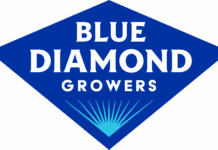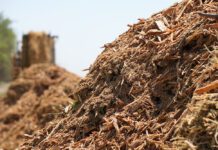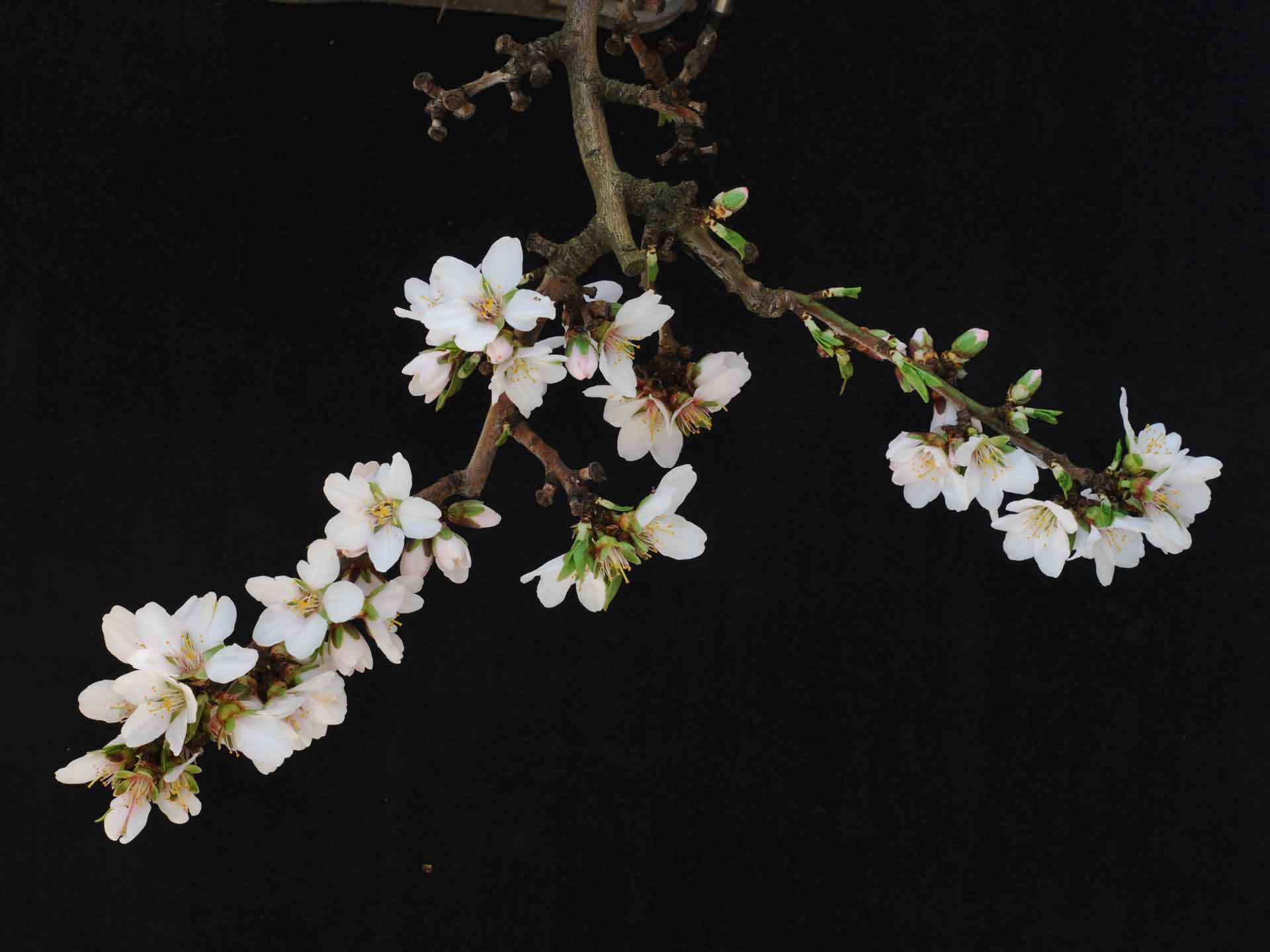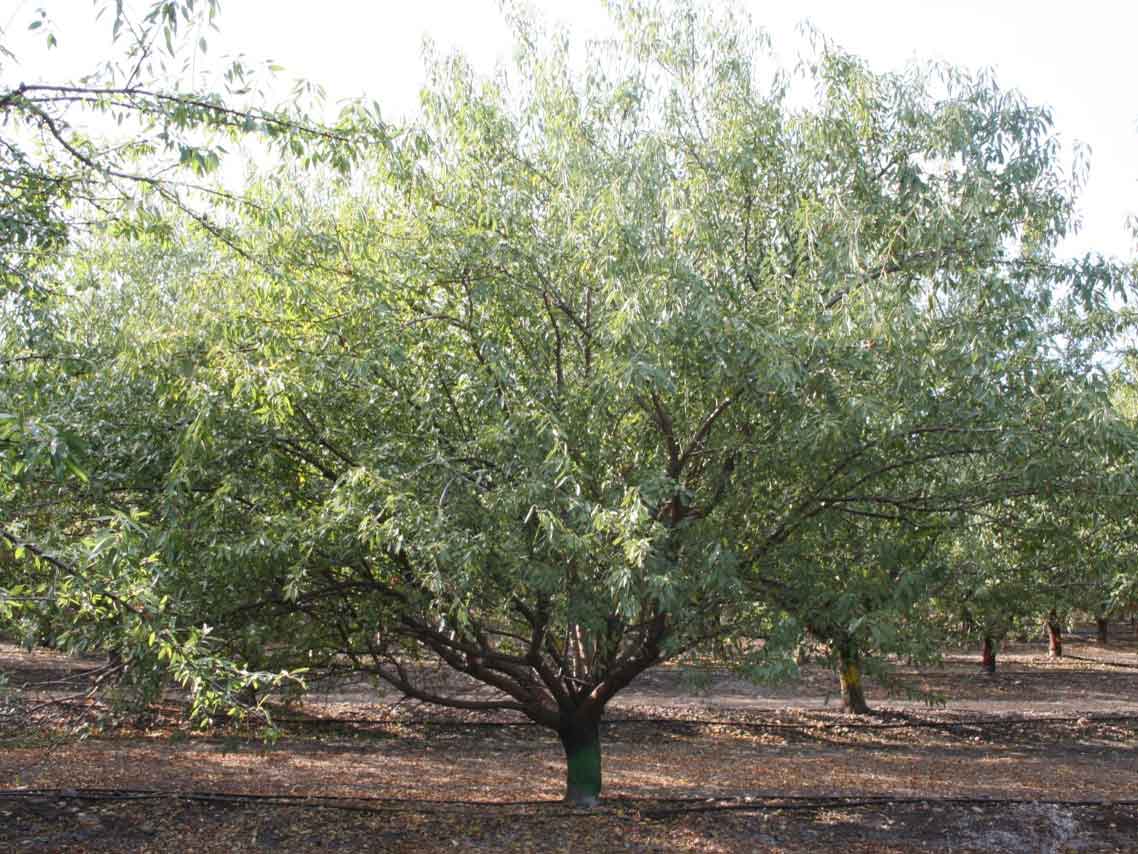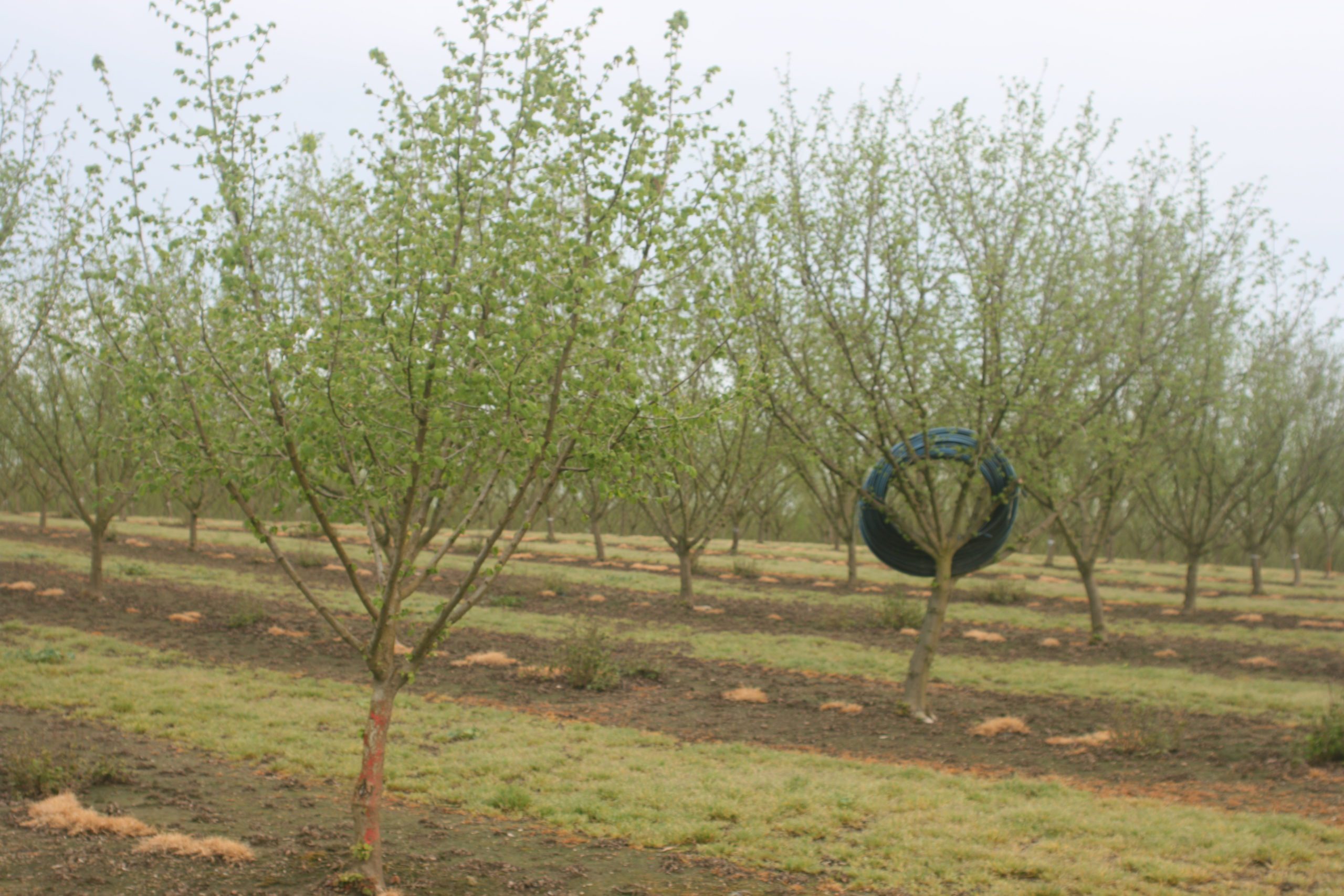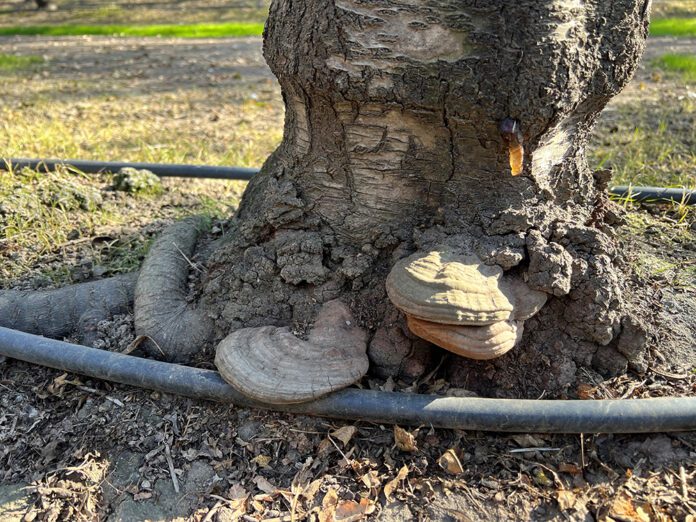
Listen to the audio version of this article. (Generated by A.I.)
A healthy-appearing almond tree that suddenly snaps at its base and falls over? Blame Ganoderma adspersum, an aggressive fungal disease that causes extensive rotting of tree roots and tree base.
G. adspersum is a wood decay fungus that emerged first in southern San Joaquin Valley almond orchards in 2016 and now can be found in orchards from Madera to Kern County. Fungal infection of the roots and base of the tree causes white rot, weakening the tree structure. A wind event or harvest shake can cause an infected tree to snap at the base and fall over.
There are four kinds of Ganoderma in California, but G. adspersum has recently emerged as an important disease of almonds. This group of plant pathogens spreads from tree to tree by spores that are released from fruiting bodies into the air. The timing of heightened spore production of G. adspersum happens to coincide with harvest activities in almond. As a result, the shaking of trees during harvest might promote spread of the disease. Trees as young as four years old have been infected, though the average age is about 14, according to Bob Johnson, a former UC Davis plant pathology Ph.D. student who has studied the spread of Ganoderma.
Almond Board of California (ABC) reports that Ganoderma can go undetected for as many as five years before signs of a fruiting body begin to show.
A principal investigator of this disease, UCCE Farm Advisor Elizabeth Fichtner in Tulare County, has been conducting studies on prevention of G. adspersum infection in orchards and the potential relationship between the disease and crown gall.
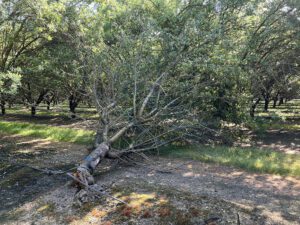
Aggressive Pathogen
Fichtner noted this wood decay fungus had no prior record of infections in North America prior to emerging as a pathogen of almond, prune and peach rootstock ten years ago. She said the pathogen has been found to be particularly aggressive on trees on Nemagard rootstock. It also appears to be prevalent in orchards with a high incidence of crown gall. There are no known disease management strategies currently.
Trees infected with G. adspersum are identified by the presence of fruiting bodies, known as conks. These are thick-based, semicircular, shelf-like growths on tree trunks, mostly at the base of the tree. Fichtner said once these conks, which are the source of fungal spores, are visible, the fungus has already invaded the tree. While removal of the conks can reduce the amount of inoculum in the orchard, it does nothing for the affected tree. Conks will regrow on the tree in a matter of months, she said.
Fichtner, along with UCCE Farm Advisors Mohammad Yagmour in Kern county and Raymond Mireles in Tulare County, established studies last year to address management of G. adspersum infections in almond orchards with phosphite applications. They were also evaluating efficacy of excising fruiting bodies to mitigate disease transmission.
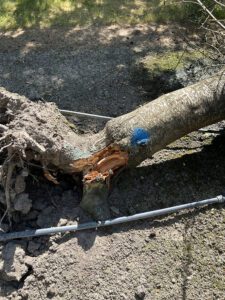
Kphite 7LP Study
Fichtner’s studies focus on use of a Kphite® 7LP to prevent spread of G. adspersum in an orchard.
“Prevention should start early when the first signs of disease are found in an orchard. Prevention is key to extending an orchard’s longevity,” Fichtner said.
ABC-funded research showed the average age of infected trees is about 14. Growers with severe Ganoderma infections have had to remove orchards at less than half of their productive lifespans.
Phosphites are salts derived from phosphorous acid. They are characterized by having a phosphorus atom bonded to three oxygen atoms. Phosphorous acid is the parent acid of phosphites. Phosphite salts are formed by replacing the hydrogen atoms in phosphorous acid with other cations
Phosphite products are known to induce plant defense responses to pathogens, preventing infections. Fichtner said the tested product, Kphite 7LP, is a Plant Food Company Inc. product but is not considered a fertilizer. It is registered as a fungicide/bactericide with EPA and is known to control other plant diseases including Botryosphaeria and Phytophthora.
In the trial, 16 rows of Nonpareil and one row each of Monterey and Fritz trees infected were labeled and fruiting bodies excised. The regrowth of the conks was evaluated monthly in 2024. Using a randomized complete block design in the trial, Kphite 7LP was applied as a foliar spray at 7 liters per acre to eight Nonpareil rows and eight untreated rows. Four rows each of Fritz and Monterey were treated with Kphite 7LP at 9.4 liters per acre applied by chemigation and four rows remained untreated. All phosphite-treated rows were treated in April and July 2024. Fichtner said that over 70% of fruiting bodies regrew within a year of excision and neither the foliar nor chemigation treatments in the orchard had any effect on regrowth. Chemigation with Kphite 7LP did not affect disease progress, but the foliar treatments reduced the development of new G. adspersum infections by 25% in the first year.
Fichtner stressed that for the foliar applications to be effective, the entire tree must be treated. Results of the trial showed while disease suppression is unlikely with conk removal, the foliar Kphite 7LP application may limit disease progress and extend orchard longevity.
An ABC-funded study by UC researcher David Rizzo found that G. adspersum spores present in large amounts during August and September when harvest is underway. His findings suggest a need to assess dust reduction practices to reduce spore transmission.
In the Mireles, Yagmour and Fichtner study of the relationship between G. adspersum infections and crown gall, more than 6,000 trees were surveyed across two orchards in February 2024 and rated for incidence of each disease.
Both orchards were on Nemaguard rootstock and included Nonpareil, Monterey, and Fritz varieties. Results of the study indicated a significant association between G. adspersum and crown gall infection on all varieties in both orchards.
The study found a strong link between crown gall and G. adspersum infection. On Fritz and Monterey trees at both sites, and on Nonpareil at one site, each unit increase in crown gall incidence resulted in more than a 1×109 (one-billion-fold) increase in the likelihood of Ganoderma infection. On Nonpareil trees at the second site, the risk increased more than 87-fold. The results support the hypothesis that crown gall predisposes almonds to infection by G. adspersum. Further studies are needed to address the mechanism by which crown gall infection predisposes almond to G. adspersum with the long-term goal of improving the economic lifespan of California almond orchards.

Cecilia Parsons | Associate Editor
Cecilia Parsons has lived in the Central Valley community of Ducor since 1976, covering agriculture for numerous agricultural publications over the years. She has found and nurtured many wonderful and helpful contacts in the ag community, including the UCCE advisors, allowing for news coverage that focuses on the basics of food production.
She is always on the search for new ag topics that can help growers and processors in the San Joaquin Valley improve their bottom line.
In her free time, Cecilia rides her horse, Holly in ranch versatility shows and raises registered Shetland sheep which she exhibits at county and state fairs during the summer.








